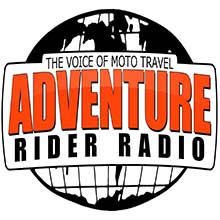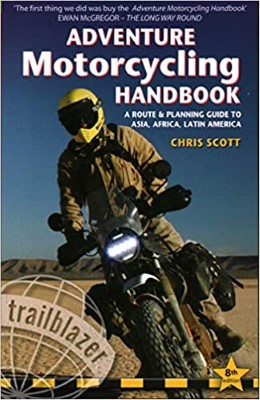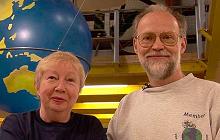 6Likes 6Likes
-
 3
Post By PanEuropean
3
Post By PanEuropean
-
 1
Post By PanEuropean
1
Post By PanEuropean
-
 1
Post By Keith1954
1
Post By Keith1954
-
 1
Post By IanJ
1
Post By IanJ
 |

5 Oct 2014
|
|
Registered Users
Veteran HUBBer
|
|
Join Date: Nov 2013
Posts: 679
|
|
|
Changing N xxx W xxx into x.xxx,-xx.xxxx ?
Confusing title, basically when I find GPS coordinates, they are usually as so;
9.2512833,-83.8635667
But on my eTrex 20, when I try to enter them in, they are in a different format, as so;
N 09 15.077 W 083 51.814
In the preferences - Position Format - they are set to;
hddd°mm.mmm
WGS 84
WGS 84
- Sort of confused, changing these does not seem to make a difference. Can anyone explain? I tried searching this but no luck.
Many thanks,
Rtw
|

5 Oct 2014
|
|
Banned
Veteran HUBBer
|
|
Join Date: Dec 2009
Posts: 973
|
|
On my Garmin i can change between different GPS formates. Otherwise you can enter them into google earth and it will return the "normal" format 
|

5 Oct 2014
|
|
Registered Users
Veteran HUBBer
|
|
Join Date: Nov 2013
Posts: 679
|
|
|
Could you tell me how do you change to different formats and what are they called?
Cheers!
|

5 Oct 2014
|
|
Gold Member
Veteran HUBBer
|
|
Join Date: Jan 2002
Location: Toronto, Canada
Posts: 2,125
|
|
Quote:
Originally Posted by ridetheworld

...In the preferences - Position Format - they are set to;
hddd°mm.mmm
WGS 84
WGS 84
- Sort of confused...
|
There are two totally different issues involved here, and it is important that you do not confound the two.
The first is the question of what map datum you are using, the second is what notation you are expressing (writing) a location with.
Concerning datums:
A bazillion years ago, when man first started creating paper maps, one of the first things he discovered was that any map that was drawn that had any form of grid system overlaid on it to enable a location to be identified needed to have a map datum defined.
The Romans were probably the first to make widespread use of datums, referencing everything to the distance from Rome. Eventually, other datums were established, primarily when the new area being mapped was separated from the old area by a large expanse of sea, making it impossible to connect to an established datum. Hence, there was a 1841 Basel datum (worked OK for Europe), then an Australian datum when that place got mapped, various Russian datums, a datum specific to Mount Everest, etc. etc.
Having all those different datums was no problem until people started to navigate intercontinentally (i.e. across datums) on a regular basis. At that point in time, the need for a 'worldwide' reference datum arose. This was first met by the WGS (World Geodetic Survey) datum of 1960. As the science of measurement advanced, that datum was refined and updated, resulting in WGS 1966 and WGS 1972.
Finally, the 'worldwide' datum (WGS), the one that most everyone agreed to use, was refined into its present version by the international scientific community and published as WGS 84 (this was done, no prizes for guessing, in 1984).
WGS 84 is sufficient for millimeter-precision definition of location, and it is the datum that is used by the NavStar Global Positioning System that is operated by the United States Military (what we call 'GPS').
Many years ago, when various long range positioning systems were developed (LORAN, OMEGA, etc.), users were still plotting position (latitude and longitude) derived from the positioning system onto paper charts drawn to a multitude of different datums (well over 100 different datums). Hence, early long range positioning systems offered the user a selection of datums that could be used, this to eliminate the need to do complex mathematics to correct from the positioning system's datum to the datum of the paper chart being used.
I remember flying in Africa in the 1980s when we used OMEGA navigation for position determination... some of the paper maps we had were published in the 1950s, and still used datums that were probably established by Stanley and Livingstone when they first charted that continent. Those days are gone now.
Today, just about all the paper maps published in the past 30 years have been referenced to WGS 84. This means you can take a position (lat/long reference) from a long range positioning system and transfer it onto a paper map without any need to convert datums. For that reason, it is becoming less common for consumer level GPS units to offer the ability to select different datums... because everyone uses WGS 84. There are still a limited number of paper maps printed that use a datum other than WGS 84, but in those rare cases, the measurement difference from WGS 82 amounts to only millimeters, which is of no significance for hikers, riders, or drivers.
Naturally, if your GPS system included electronic maps, you can take for granted that the electronic map will be referenced to the WGS 84 datum... you don't even need to think about it.
----------------------------------
Now, getting around to the notation - the method used to express a latitude/longitude in numbers - that is something entirely different that has nothing to do with datums. It is also a lot simpler to comprehend.
Think of how we express time: Hours, minutes, and seconds. It's not a decimal (base 10) system. There are 12 hours (24 if we use a 24 hour clock), with 60 minutes in each hour and 60 seconds in each minute. We can describe this time notation as hh' mm'' ss''', or hh m' ss'', or in other similar ways. However we express it, you get the idea, it means hours, then minutes (1/60 of an hour), then seconds (1/60 of a minute).
If we wanted to use decimal notation for expressing time, we would just need to break the hours into units of 100 minutes each, and the minutes into units of 100 seconds each. Hence "twelve-thirty PM' would be written as 12.50.00 (note the decimal points), rather than 12'30''00'''. Similarly, twelve forty-five and twenty seconds would be written as 12.75.33.
Noting latitude and longitude in hours, minutes, and seconds (with 60 units in the minutes and seconds) was the common system for many, many years. With the widespread adoption of the decimal system and use of computers for doing calculations, it became obvious that it is somewhat simpler, and less prone to error, to use decimal notation rather than base 60 notation.
You can use whatever system you want, just be sure not to mix the two. Most GPS navigation devices give the user the option of choosing the notation system that is used. Most paper maps still use the base 60 system to draw the scales on the edges of the map, which is why the base 60 system persists today.
If you are transferring co-ordinates from a paper map to your GPS device (or vice-versa), it might be easiest to set your GPS device to use hours, minutes, and seconds. If you are not making such transfers, then it doesn't matter at all what notation system your GPS device uses.
Hope this helps.
Michael
|

5 Oct 2014
|
|
Gold Member
Veteran HUBBer
|
|
Join Date: Jan 2002
Location: Toronto, Canada
Posts: 2,125
|
|
Quote:
Originally Posted by ridetheworld

Could you tell me how do you change to different formats and what are they called?
|
If you want a quick and easy way to change notation from HH:MM:SS to decimal and vice-versa, go to this website:
Degrees/Minutes/Seconds to/from Decimal Latitude/Longitude
You could also do your own conversions using high school math (to convert from base 60 to base 10), but that is prone to error... 
Just as an aside, for sake of interest, if you look closely at that website, you will see that mention is made of two different datums, one being WGS 84 and the other being NAD 83 (North American Datum 1983). The maximum difference possible between those two datums is 2 millimeters, which is why NAD 83 is still found in use today (primarily in Canadian aviation cartography). Two millimeters doesn't matter to anyone except land surveyors.
But, I stress, you can completely ignore the concept of datum, unless you are using very old maps from very strange places.
Michael
|

6 Oct 2014
|
|
Registered Users
Veteran HUBBer
|
|
Join Date: Sep 2006
Location: Cornwall, in the far southwest of England, UK
Posts: 597
|
|
I love reading your replies Michael. Always, bloody excellent ..  .
.
|

6 Oct 2014
|
|
Gold Member
Veteran HUBBer
|
|
Join Date: Jan 2002
Location: Toronto, Canada
Posts: 2,125
|
|
|
Thanks Keith, kind of you to say that.
Michael
|

6 Oct 2014
|
|
Contributing Member
Veteran HUBBer
|
|
Join Date: Feb 2005
Location: Australia
Posts: 131
|
|
Quote:
Originally Posted by ridetheworld

Confusing title, basically when I find GPS coordinates, they are usually as so;
9.2512833,-83.8635667
But on my eTrex 20, when I try to enter them in, they are in a different format, as so;
N 09 15.077 W 083 51.814
In the preferences - Position Format - they are set to;
hddd°mm.mmm
WGS 84
WGS 84
- Sort of confused, changing these does not seem to make a difference. Can anyone explain? I tried searching this but no luck.
Many thanks,
Rtw
|
Greetings RTW
In the menu does your Settings > Position Format give you the option to change hddd°mm.mmm to hddd.ddddd° ?
If it does change it, and that will give you the simple decimal degree number (ddd.ddddd°) with a hemisphere (h)
To translate the hemisphere
N = +
S = -
E = +
W = -
You can see how it works using the latitude/longitude you gave.
I would assume that the Map Datum would stay the same (WGS 84) it does on my 60csx.
When I want to add a waypoint manually to my GPS using the lat/lon coords, I can add/edit the coords using the keypad.
I don't know if this is what you are trying to do?
Good Luck
IanJ
|

6 Oct 2014
|
|
Registered Users
Veteran HUBBer
|
|
Join Date: Nov 2013
Posts: 679
|
|
Wow Thanks again Micheal, that was a fascinating read. I am loving my GPS now as I realise it is a skill unto itself! And an interesting one of that!
Quote:
Originally Posted by IanJ

Greetings RTW
In the menu does your Settings > Position Format give you the option to change hddd°mm.mmm to hddd.ddddd° ?
If it does change it, and that will give you the simple decimal degree number (ddd.ddddd°) with a hemisphere (h)
To translate the hemisphere
N = +
S = -
E = +
W = -
You can see how it works using the latitude/longitude you gave.
I would assume that the Map Datum would stay the same (WGS 84) it does on my 60csx.
When I want to add a waypoint manually to my GPS using the lat/lon coords, I can add/edit the coords using the keypad.
I don't know if this is what you are trying to do?
Good Luck
IanJ
|
Yes, for example just so I can input the coordinates of -32.586450, -69.346867 into my WHERE TO? menu, but despite changing from hddd°mm.mmm to hddd.ddddd° in the POSITION FORMAT menu, when I return to the WHERE TO and select COORDINATES, it similarly only to enter with N/S or E/W
I mean it is not a massive problem, but most coordinates on the web are listed in the format with the - signs instead of the N/S/E/W, which means it would be nice to just punch them in to the GPSr without having to convert them...
Many thanks for the advice,
Rtw
|

6 Oct 2014
|
 |
Registered Users
Veteran HUBBer
|
|
Join Date: May 2004
Location: Oxnard, Ca. USA
Posts: 187
|
|
 Clearing some confusion.
Clearing some confusion.
Quote:
Originally Posted by PanEuropean

Noting latitude and longitude in hours, minutes, and seconds (with 60 units in the minutes and seconds) was the common system for many, many years. With the widespread adoption of the decimal system and use of computers for doing calculations, it became obvious that it is somewhat simpler, and less prone to error, to use decimal notation rather than base 60 notation.
You can use whatever system you want, just be sure not to mix the two. Most GPS navigation devices give the user the option of choosing the notation system that is used. Most paper maps still use the base 60 system to draw the scales on the edges of the map, which is why the base 60 system persists today.
If you are transferring co-ordinates from a paper map to your GPS device (or vice-versa), it might be easiest to set your GPS device to use hours, minutes, and seconds. If you are not making such transfers, then it doesn't matter at all what notation system your GPS device uses.
Hope this helps.
Michael
|
Michael, You are the man on this I see so maybe you can expand on something I saw several years ago regarding the accuracy of the different decimal notations. This was an article on reporting your position for rescue operations. I remember seeing a chart showing 3 DIFFERENT positions depending on how the coordinates were reported. I believe I remember that Hours, minutes, and seconds was the most accurate followed by Hours, minutes, and decimal minutes (34 degrees 45.12345 minutes) and that Hours, decimal hours (34.123456) was the least accurate. I seem to remember there was quite a difference in where the spots were on the chart between the first example and the last, less so between the first and second. Do you agree and can you expand? I changed the chart plotter on my boat to Hours, minutes, and seconds hoping I never had to report my position for those reasons. :=)
Thanks Rick
|

7 Oct 2014
|
|
Gold Member
Veteran HUBBer
|
|
Join Date: Jan 2002
Location: Toronto, Canada
Posts: 2,125
|
|
|
Hello Rick:
The notation used to describe the X-Y co-ordinates of a location has no impact on the accuracy of the description of the location, other than the obvious, which is that the more significant digits there are, the more accurate the location will be.
Let me try to explain that a bit better:
Paris, France has a large tower designed by Eiffel in the middle of the city. We can note (notate?) the co-ordinates of that tower in a number of different ways, such as -
48.85837, 2.294481 This is how most GPS devices and most GIS (Geographic Information Systems) store and define the location. It is decimal, with 48 being the latitude and 2 being the longitude. The latitude is north and the longitude is east. South latitude and west longitude would be preceded by a minus sign.
Regardless of how you have configured your GPS device to display lat/long to you, this is most likely how the device stores waypoints within it.
N48° 51' 30.132" E2° 17' 40.1316" This is the same location, expressed in degrees-minutes-seconds. The level of precision is the same, because the number of significant digits is the same.
It is noteworthy that even though the above notation is degrees-minutes-seconds, a decimal value (fraction of a second) is appended to the seconds in order to achieve the same degree of precision as the first example.
If the decimal fraction of a second was not appended, the result would be N48° 51' 30 E2° 17' 40, which doesn't have the same level of precision only because it has fewer significant digits.
There are many other ways of noting a location - UTM notation is commonly used by military forces (including Search and Rescue), and UTM is an entirely different way of describing a location.
--------------
The best analogy I can think of is to compare normal decimal numbers that we use in everyday life with Roman Numerals or hexadecimal notation. We can write the current year as 2014, or as MMXIV, or as (838)[sub]16[/sub]. It's all the same thing, and all three values have the same level of precision (only to the 'year' level, not to the day or month of the year).
Hope this helps,
Michael
PS: In the last paragraph above, the '16' after 838 should appear as a subscript, to indicate that it is base 16 notation. But this forum does not support the UBB code for a subscript, which is why you see the formatting code 'sub' before and after the number 838.
|
|
Currently Active Users Viewing This Thread: 1 (0 Registered Users and/or Members and 1 guests)
|
|
|
 Posting Rules
Posting Rules
|
You may not post new threads
You may not post replies
You may not post attachments
You may not edit your posts
HTML code is Off
|
|
|
|

Check the RAW segments; Grant, your HU host is on every month!
Episodes below to listen to while you, err, pretend to do something or other...

2020 Edition of Chris Scott's Adventure Motorcycling Handbook.
"Ultimate global guide for red-blooded bikers planning overseas exploration. Covers choice & preparation of best bike, shipping overseas, baggage design, riding techniques, travel health, visas, documentation, safety and useful addresses." Recommended. (Grant)

Ripcord Rescue Travel Insurance™ combines into a single integrated program the best evacuation and rescue with the premier travel insurance coverages designed for adventurers.
Led by special operations veterans, Stanford Medicine affiliated physicians, paramedics and other travel experts, Ripcord is perfect for adventure seekers, climbers, skiers, sports enthusiasts, hunters, international travelers, humanitarian efforts, expeditions and more.
Ripcord travel protection is now available for ALL nationalities, and travel is covered on motorcycles of all sizes!
What others say about HU...
"This site is the BIBLE for international bike travelers." Greg, Australia
"Thank you! The web site, The travels, The insight, The inspiration, Everything, just thanks." Colin, UK
"My friend and I are planning a trip from Singapore to England... We found (the HU) site invaluable as an aid to planning and have based a lot of our purchases (bikes, riding gear, etc.) on what we have learned from this site." Phil, Australia
"I for one always had an adventurous spirit, but you and Susan lit the fire for my trip and I'll be forever grateful for what you two do to inspire others to just do it." Brent, USA
"Your website is a mecca of valuable information and the (video) series is informative, entertaining, and inspiring!" Jennifer, Canada
"Your worldwide organisation and events are the Go To places to for all serious touring and aspiring touring bikers." Trevor, South Africa
"This is the answer to all my questions." Haydn, Australia
"Keep going the excellent work you are doing for Horizons Unlimited - I love it!" Thomas, Germany
Lots more comments here!

Diaries of a compulsive traveller
by Graham Field
Book, eBook, Audiobook
"A compelling, honest, inspiring and entertaining writing style with a built-in feel-good factor" Get them NOW from the authors' website and Amazon.com, Amazon.ca, Amazon.co.uk.
Back Road Map Books and Backroad GPS Maps for all of Canada - a must have!
New to Horizons Unlimited?
New to motorcycle travelling? New to the HU site? Confused? Too many options? It's really very simple - just 4 easy steps!
Horizons Unlimited was founded in 1997 by Grant and Susan Johnson following their journey around the world on a BMW R80G/S.
 Read more about Grant & Susan's story
Read more about Grant & Susan's story
Membership - help keep us going!
Horizons Unlimited is not a big multi-national company, just two people who love motorcycle travel and have grown what started as a hobby in 1997 into a full time job (usually 8-10 hours per day and 7 days a week) and a labour of love. To keep it going and a roof over our heads, we run events all over the world with the help of volunteers; we sell inspirational and informative DVDs; we have a few selected advertisers; and we make a small amount from memberships.
You don't have to be a Member to come to an HU meeting, access the website, or ask questions on the HUBB. What you get for your membership contribution is our sincere gratitude, good karma and knowing that you're helping to keep the motorcycle travel dream alive. Contributing Members and Gold Members do get additional features on the HUBB. Here's a list of all the Member benefits on the HUBB.
|
|
|
 6Likes
6Likes
 6Likes
6Likes